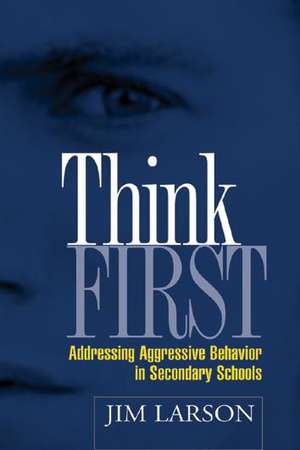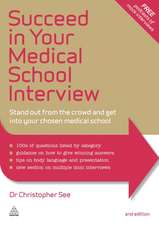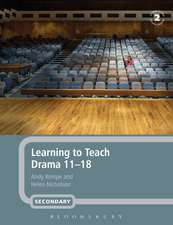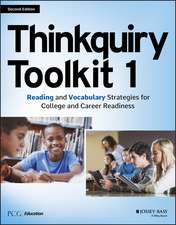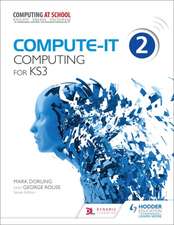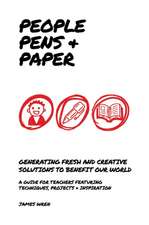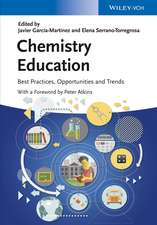Think First: Addressing Aggressive Behavior in Secondary Schools: The Guilford School Practitioner Series
Autor Jim Larsonen Limba Engleză Paperback – 7 apr 2005
This highly practical book presents a complete anger and aggression management training program for middle and high school students. The volume incorporates a revised version of the author's proven "Think First" manual, which includes step-by-step skills training guidelines and 20 reproducible handouts and forms. Also provided are a clear rationale for the program and thorough instructions for screening and assessing those students who could benefit most from participation. Showing how to integrate small-group cognitive-behavioral skills training into an effective schoolwide disciplinary framework, the book offers vital tools for promoting prosocial behavior and decreasing violence risks among all students. It is an essential resource for professionals who seek both a better understanding of adolescent aggression and nuts-and-bolts strategies for dealing with it.
Preț: 248.30 lei
Nou
Puncte Express: 372
Preț estimativ în valută:
47.52€ • 49.43$ • 39.23£
47.52€ • 49.43$ • 39.23£
Carte tipărită la comandă
Livrare economică 14-28 aprilie
Preluare comenzi: 021 569.72.76
Specificații
ISBN-13: 9781593851262
ISBN-10: 159385126X
Pagini: 208
Dimensiuni: 178 x 254 x 12 mm
Greutate: 0.4 kg
Ediția:New.
Editura: Guilford Publications
Colecția Guilford Press
Seria The Guilford School Practitioner Series
ISBN-10: 159385126X
Pagini: 208
Dimensiuni: 178 x 254 x 12 mm
Greutate: 0.4 kg
Ediția:New.
Editura: Guilford Publications
Colecția Guilford Press
Seria The Guilford School Practitioner Series
Public țintă
Postgraduate and Professional Practice & DevelopmentCuprins
1. The Problem and Directions for Change
2. The Context of Aggressive Student Behavior: Creating Effective, Whole-School Environmental Strategies
3. Rationale and Best Practices for Anger and Aggression Management Skills Training
4. Screening, Identification, and Assessment for Anger and Aggression Management Training
5. Getting Started with Anger and Aggression Management Skills Training
6. Introduction to the Treatment Manual
Module I. Introduction, Choices, and Consequences
Module II. Hassle Log and Anger Reducers
Module III. Anger Triggers and Attribution Retraining
Module IV. Self-Instruction and Consequential Thinking
Module V. Social Problem-Solving
Appendices:
A. Current Behavior Screening Form
B. Intervention Record Review
C. Adolescent Interview
D. Brief Problem Assessment Interview
E. Classroom Progress Monitoring Report
F. Multidimensional School Anger Inventory
G. Sample Parental Consent Letter/Carta de Consentimiento de Padres
H. Guidelines for Generalization Support Persons
I. Academic Self-Monitoring Form
J. Think First Training Outcomes
Handouts:
Think First Handout I.1. Behavior A-B-C's
Think First Handout II.1. Hassle Log
Think First Handout II.2. Behavior A-B-C's for an Anger Cue
Think First Handout III.1. Common Thought Triggers
Think First Handout IV.1. Reminders
Think First Handout V.1. Stop And Think
Think First Handout V.2. Finding Alternative Solutions
Think First Handout V.3. Problem-Solving Work Sheet
2. The Context of Aggressive Student Behavior: Creating Effective, Whole-School Environmental Strategies
3. Rationale and Best Practices for Anger and Aggression Management Skills Training
4. Screening, Identification, and Assessment for Anger and Aggression Management Training
5. Getting Started with Anger and Aggression Management Skills Training
6. Introduction to the Treatment Manual
Module I. Introduction, Choices, and Consequences
Module II. Hassle Log and Anger Reducers
Module III. Anger Triggers and Attribution Retraining
Module IV. Self-Instruction and Consequential Thinking
Module V. Social Problem-Solving
Appendices:
A. Current Behavior Screening Form
B. Intervention Record Review
C. Adolescent Interview
D. Brief Problem Assessment Interview
E. Classroom Progress Monitoring Report
F. Multidimensional School Anger Inventory
G. Sample Parental Consent Letter/Carta de Consentimiento de Padres
H. Guidelines for Generalization Support Persons
I. Academic Self-Monitoring Form
J. Think First Training Outcomes
Handouts:
Think First Handout I.1. Behavior A-B-C's
Think First Handout II.1. Hassle Log
Think First Handout II.2. Behavior A-B-C's for an Anger Cue
Think First Handout III.1. Common Thought Triggers
Think First Handout IV.1. Reminders
Think First Handout V.1. Stop And Think
Think First Handout V.2. Finding Alternative Solutions
Think First Handout V.3. Problem-Solving Work Sheet
Notă biografică
Jim Larson, PhD, is Professor of Psychology and Director of the School Psychology Program at the University of Wisconsin-Whitewater. He is also a member of the Scientific Board of the Melissa Institute for Violence Prevention and Treatment of Victims of Violence. Before moving to the University of Wisconsin-Whitewater, Dr. Larson was a school psychologist with the Milwaukee Public Schools in Milwaukee, Wisconsin, and the lead psychologist with the Milwaukee schools' Violence Prevention Program. His principal research interests include the treatment of aggression in children and adolescents, school violence prevention, and training procedures in school psychology. He is coauthor (with John E. Lochman) of Helping Schoolchildren Cope with Anger: A Cognitive-Behavioral Intervention.
Recenzii
Larson's book is based on solid conceptual principles with a well-researched background. The Think First training modules are logically laid out and easy to follow, with a wealth of helpful hints for novice and experienced practitioners alike. One exceptional point is made that is worth the price of the book: intervention and teaching skills are inadequate without generalization in the real world. One must also practice, practice, practice. School psychologists, administrators, teachers, and those responsible for training these professionals should take note of this text and add it to their toolbox of interventions, as well as incorporating it into training programs. Overall, this is an excellent resource.--Twylla Abrahamson, PhD, Family Residential Division, River Oak Center for Children, Sacramento, CA
This is a practical and informative guide for mental health professionals and others concerned not only with reducing the occurrence of aggressive behaviors in schools, but also with encouraging the development of prosocial alternatives. Presented is a research-based, cognitive-behavioral intervention, including step-by-step guidelines for practitioners. I recommend this book as a useful text for graduate-level clinical training in school psychology, school social work, and education.--Douglas C. Smith, PhD, Department of Counselor Education, University of Hawaii
Outstanding....This book makes unique contributions both to understanding aggressive behavior in school settings and to screening, identification, and assessment practices for school personnel. Mental health and student support services personnel will find the five-module treatment manual an excellent resource from which a school-based intervention system can be crafted. Think First would make an excellent text for intervention courses and seminars that focus on aggression and other types of externalizing behaviors.--George M. Batsche, EdD, Graduate Programs in School Psychology and Institute for School Reform, University of South Florida
This book is full of useful material for professionals in middle and secondary learning environments. Included are research-supported sequential activities and ready-made forms that can be easily copied and used to support a well-documented, child-specific intervention. School psychologists, social workers, counselors, administrators, and teachers of at-risk students will find this a helpful tool in identifying and interrupting patterns that are leading toward increasing levels of aggression in today's youth.--Patricia Kies, EdS, School Psychologist, Parker High School, Janesville, Wisconsin
-This is a practical and informative guide for mental health professionals and others concerned not only with reducing the occurrence of aggressive behaviors in schools, but also with encouraging the development of prosocial alternatives. Presented is a research-based, cognitive-behavioral intervention, including step-by-step guidelines for practitioners. I recommend this book as a useful text for graduate-level clinical training in school psychology, school social work, and education.--Douglas C. Smith, PhD, Department of Counselor Education, University of Hawaii
Outstanding....This book makes unique contributions both to understanding aggressive behavior in school settings and to screening, identification, and assessment practices for school personnel. Mental health and student support services personnel will find the five-module treatment manual an excellent resource from which a school-based intervention system can be crafted. Think First would make an excellent text for intervention courses and seminars that focus on aggression and other types of externalizing behaviors.--George M. Batsche, EdD, Graduate Programs in School Psychology and Institute for School Reform, University of South Florida
This book is full of useful material for professionals in middle and secondary learning environments. Included are research-supported sequential activities and ready-made forms that can be easily copied and used to support a well-documented, child-specific intervention. School psychologists, social workers, counselors, administrators, and teachers of at-risk students will find this a helpful tool in identifying and interrupting patterns that are leading toward increasing levels of aggression in today's youth.--Patricia Kies, EdS, School Psychologist, Parker High School, Janesville, Wisconsin
Descriere
This highly practical book presents a complete anger and aggression management training program for middle and high school students. The volume incorporates a newly revised version of the author's proven ""Think First"" manual, which includes step-by-step skills training guidelines and 20 reproducible handouts and forms. Also provided are a clear rationale for the program and thorough instructions for screening and assessing those students who could benefit most from participation. Showing how to integrate small-group cognitive-behavioral skills training into an effective schoolwide disciplinary framework, the book offers vital tools for promoting prosocial behavior and decreasing violence risks among all students. It is an essential resource for professionals who seek both a better understanding of adolescent aggression and nuts-and-bolts strategies for dealing with it.
